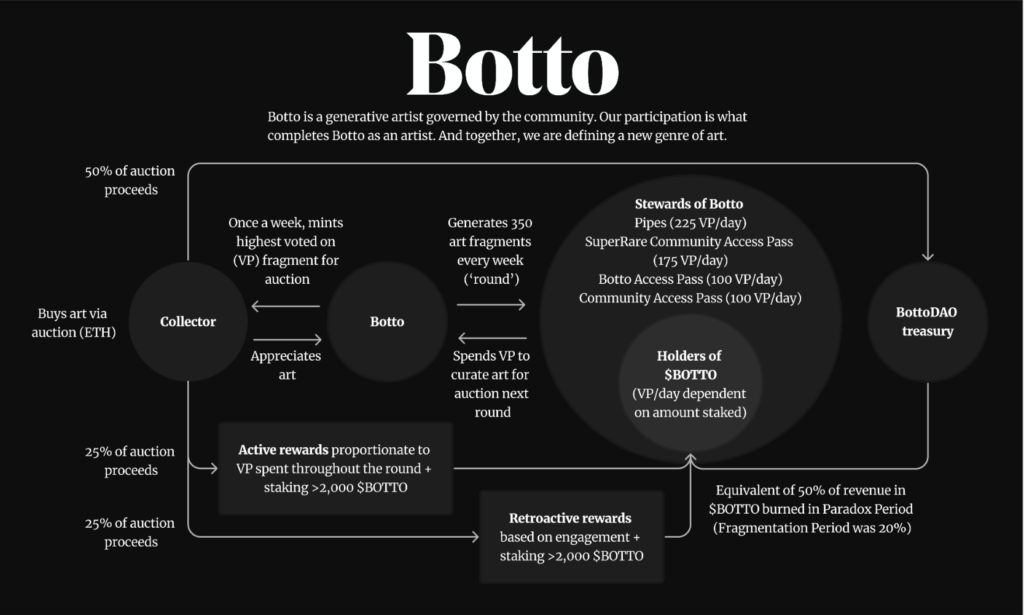Tina Dai

Generative Art Will Be a Multiplayer Exercise in Meaning-Making
Where human and machine creation converge, a multiplayer ecosystem will emerge to shape a collective meaning-making experience on crypto rails.
Art is an essential aspect of human culture, a core element of society that reflects the ideas and values of different generations and their multifaceted truths. Through art, we get to commune directly with the artist by seeing the world through their eyes.
You might think all of that gets sacrificed with generative art, the high fidelity union of creativity and code that has exploded in the past few years. Many skeptics feel a knee-jerk reaction to any content that leverages AI; that is a reputational battle that will continue.
But generative art should be viewed as an extension of new avenues for human creators.
The semi-automation of art production has led to a proliferation of unique and fascinating works that could not have been created by humans alone—and yet still require the human touch. Generative art also dramatically lowers the barrier to entry for art creators, democratizing the ability for anyone to create with relative ease.
Despite its many advantages, the abundance of large-language AI models raises crucial questions like: What happens to human creativity in an age of machine production? When you can create everything, what means something?
We believe generative art will ultimately be akin to a multiplayer world, where the lines between creator, machine, and ecosystem become dynamic and all parties come together to generate collective meaning in art.
The value of generative artwork will be shaped more by human stewardship than by production value alone, and an ecosystem supporting community-driven meaning-making will emerge on crypto rails.
Generative art blurs the definition of “creator” between author and machine
Generative art refers to art that utilizes algorithms and automation (mechanical or organic) to create unique and surprising outputs not entirely pre-selected by the artist. For our purposes, we are referring specifically to art generated by computer programs.
Generative art encompasses a wide range of approaches that vary by the size of the latent space and the level of human control over the final output. AI-generated art, like art created from the Stable Diffusion model, utilizes a vast latent space trained on billions of images to generate unique text-to-image artworks. Artists guide the machine’s creative process through iterative prompting. On the other hand, long-form generative art takes a more restricted approach, with artists setting specific parameters and rules for the system. The “Fidenza” series by Tyler Hobbs is a prominent example of this genre, emphasizing collaboration and performance. Through a minting process, collectors become co-creators, generating real-time, one-of-a-kind artworks. The performative nature of the collector’s minting experience adds a social element that is integral to the artwork and its lore. This example illustrates the dynamic interplay between artist, machine, and audience within the spectrum of generative art.
Generative art adds new stakeholders to the creation process, blurring the lines between the author of the artwork, machine, and the collector. This partnership between human and machine is illustrative of a new chapter of human creativity in the age of AI. The large latent spaces of AI models add a unique and unpredictable element to the creative process, even when the artist is directing it.
In the age of generative art, the notion of a single human creator evolves—authorship becomes multiplayer and collaborative with humans and machines.
Meaning-making becomes a multiplayer effort with generative art
As machines become increasingly involved in the creation of art, the value of artwork shifts from the production value to the social proof it can accrue. In other words, human involvement in meaning-making becomes crucial.
With AI models more openly accessible than ever before, there is also a lower barrier of entry for production, making it harder to capture attention. Only artists or artworks with strong social proofs will stand out.
We predict a rise of artworks that capture collective attention via memetic dynamics: memes have become a crucial part of our online culture via hivemind authorship and mass participation. Though human-initiated, memes are meaningless without group participation by the collective. Memes serve as a way for people to communicate and express their ideas in a shared language, provide social commentary and critique, and bring attention to important issues in a more digestible and accessible way.
Like memes, AI-generated art will increasingly rely on the ecosystem of stakeholders and contributors to derive value, where meaning-making becomes a collective effort, rather than relying on a singular author or creator for a piece’s narrative.
One case study in collective meaning-making is Botto, a “decentralized autonomous artist” (not human). Botto minimizes the role of a single human creator to the extreme by replacing the artist with AI to wrestle with the question: “What is the role of humans when idea generation and production are automated?” Botto can initiate and produce impressive pieces, but lacks the subjective understanding of what makes something meaningful to a particular audience. It outsources the intent and meaning of each piece to Botto’s surrounding community, the members of BottoDAO, to apply judgment and discussion in the minting process, which adds depth, context, and scarcity to the content. (See Li Jin’s recent piece for more about how Botto artworks still require human participation.)
When art production is automated, the value of AI-generated artworks will be tied to the broader ecosystem of stakeholders and contributors, and how the artwork can bridge communities to make meaning in a shared narrative. In this world, generative art becomes a medium to make sense of the systems we operate in, mediate conversations that iterate on ideas collectively, and influence the broader culture by emphasizing the open source and collaborative nature of making meaning.
An ecosystem will emerge on crypto rails to support multiplayer collaboration
The growing generative art market will require an ecosystem that supports multiplayer authorship and meaning-making. We believe the unique features that crypto offers—including on-chain provenance, proof of ownership, and group governance—make it an ideal ecosystem to support the generative art market. (See Jesse Walden’s recent piece about finding value at the intersection of AI abundance and on-chain scarcity in generative art.) NFTs serve as a record of human interactions with machines, and track the evolution of interactions over time. In this way, NFTs are a container for social meaning, while doubling as a unit of financial speculation. With NFTs as the port of entry, surrounding crypto rails provide the necessary scale and transparency to facilitate the generative art market economy.
Generative models are proliferating in art, music, text, and beyond. Since the creation process with generative models is inherently social, new platforms to support collaboration in generative content will emerge. Our predictions:
- New tools for specialized generative content will evolve to help creators unleash their creativity and support co-creator collaboration. Art Blocks is an example of a specialized platform for long-form generative art; similarly, new tools will emerge to support specialized content like generative music and beyond.
- Meaning-making will dominate the mindshare of discovery, and take shape primarily in the form of top-down curation, and grassroots proliferation:
- Curation: Creators will seek to build their brand around their ability to showcase and contextualize creations in a way that elevates value and cultural importance. Platforms will do the same, aiming to build a brand around curation and bundle distribution in its platform, effectively becoming “kingmakers” in generative content. We are already starting to see this with platforms like Art Blocks and SuperRare that showcase the immense value of the curation layer—their brand power adds an extra dimension of exclusivity and quality to artwork they feature.
- DAOs: In a grassroots fashion, DAOs and interest communities will be coordinated on crypto rails, formed by groups of people who are passionate about specific artists or projects, such as Botto or NounsDAO. Over time, these communities and DAOs may grow in size and influence, which will mobilize and recruit concentric circles around meaning-making for their projects. Projects like gm.Studio and GrailersDAO are examples of such communities that bring artists together in the pursuit of incubating and collecting high-quality generative art.
- As new forms of content emerge and grow, new verticalized playgrounds for consumption will also emerge. Projects will rise to facilitate non-traditional forms of consumption, such as a remixing platform to edit or build upon multiple artworks, or a Spotify-type consumption platform for generative music.
As the value of artwork shifts from production value to social value, human stewardship is more important than ever in validating subjective judgments on the significance of AI-generated art and content. Introducing the machine as a co-creator challenges the notion that a single human creator is responsible for a work’s production and narrative, which makes the success of generative pieces increasingly reliant on collaboration and social meaning-making.
We see this as a greenfield opportunity for an ecosystem to emerge that supports multiplayer authorship and collaborative meaning-making to help the generative content space flourish.
+++
Simon Hudson is a core contributor to BottoDAO, stewards of Botto; Variant is an investor in Botto.
This post is for general information purposes only. It does not constitute investment advice or a recommendation or solicitation to buy or sell any investment and should not be used in the evaluation of the merits of making any investment decision. It should not be relied upon for accounting, legal or tax advice or investment recommendations. You should consult your own advisers as to legal, business, tax, and other related matters concerning any investment. Certain information contained in here has been obtained from third-party sources, including from portfolio companies of funds managed by Variant. While taken from sources believed to be reliable, Variant has not independently verified such information. Variant makes no representations about the enduring accuracy of the information or its appropriateness for a given situation. This post reflects the current opinions of the authors and is not made on behalf of Variant or its Clients and does not necessarily reflect the opinions of Variant, its General Partners, its affiliates, advisors or individuals associated with Variant. The opinions reflected herein are subject to change without being updated.

